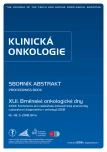Urinary MicroRNAs as Potential Biomarkers of Bladder Cancer
Authors:
J. Juráček 1; M. Staník 2; B. Peltanová 3; S. Adamcová 1; J. Doležel 2; M. Fedorko 4; L. Radová 1; O. Slabý 1
Authors‘ workplace:
CEITEC – Středoevropský technologický institut, MU, Brno
1; Oddělení urologické onkologie, Masarykův onkologický ústav, Brno
2; Ústav biochemie, PřF MU, Brno
3; Urologická klinika LF MU a FN Brno
4
Published in:
Klin Onkol 2018; 31(Supplementum1): 155-157
Category:
Article
Overview
Background:
Currently, there are no urinary-based tumour markers with sufficient sensitivity and specificity to replace cystoscopy in the detection of bladder cancer (BCA). Urinary microRNAs are emerging as clinically useful class of biomarkers for early and non-invasive detection of urologic malignancies.
Patients and Methods:
In this study, 155 patients with BCA and 83 healthy controls were enrolled. Expression profiles of urinary miRNAs were obtained using Affymetrix miRNA microarrays and candidate miRNAs further validated in independent cohort using specific TaqMan assays and quantitative real-time polymerase chain reaction method.
Results:
Whole-genome profiling identified miRNA signature with significantly different concentrations in urine of BCA compared to controls (p < 0.01). In the independent validation phase of the study, three miRNAs were confirmed to have significantly higher levels in urine of patients with BCA in comparison with control groups (p < 0.0001). In addition, we observed significant decrease in two miRNAs (p < 0.01) concentrations in the urinary samples collected 3 months after surgery compared to pre-operative samples.
Conclusion:
We identified and validated miRNAs to have significantly higher concentrations in urine of patients with BCA in comparison with controls. Our data have shown that urinary miRNAs could serve as sensitive and specific biomarkers enabling non-invasive detection of BCA.
Key words:
urinary microRNAs – biomarkers – bladder cancer
The authors declare they have no potential conflicts of interest concerning drugs, products, or services used in the study.
The Editorial Board declares that the manuscript met the ICMJE recommendation for biomedical papers.
This study was supported by Ministry of Health of the Czech Republic, grant No. 15-31071A. All rights reserved.
Submitted:
19. 3. 2018
Accepted:
20. 3. 2018
Sources
1. Antoni S, Ferlay J, Soerjomataram I et al. Bladder cancer incidence and mortality: a global overview and recent trends. Eur Urol 2017; 71 (1): 96–108. doi: 10.1016/j.eururo.2016.06.010.
2. Colombel M, Soloway M, Akaza H et al. Epidemiology, staging, grading, and risk stratification of bladder cancer. Eur Urol Suppl 2008; 7 (10): 618–626. doi: 10.1016/j.eursup.2008.08.002.
3. Prout G, Barton B, Griffin P et al. Treated History of Noninvasive Grade 1 Transitional Cell Carcinoma. J Urol 1992; 148 (5): 1413–1419.
4. Lee C, Yoon C, Witjes J. The past, present and future of cystoscopy: the fusion of cystoscopy and novel imaging technology. BJU Int 2008; 102 (9 Pt B): 1228–1233. doi: 10.1111/j.1464-410X.2008.07964.x.
5. Lu J, Getz G, Miska E et al. MicroRNA expression profiles classify human cancers. Nature 2005; 435 (7043): 834–838. doi: 10.1038/nature03702.
6. Mlcochova H, Hezova R, Stanik M et al. Urine microRNAs as potential noninvasive biomarkers in urologic cancers. Urol Oncol 2014; 32 (1): 41.e1–e9. doi: 10.1016/j.urolonc.2013.04.011.
7. R Core Team. R. A language and environment for statistical computing. R Foundation for Statistical Computing. [online]. Available from: http: //www.R-project. org/.
8. Fedorko M, Juracek J, Stanik M et al. Detection of let-7 miRNAs in urine supernatant as potential diagnostic approach in non-metastatic clear-cell renal cell carcinoma. Biochem Med 2017; 27 (2): 411–417. doi: 10.11613/BM.2017.043.
9. Hanke M, Hoefig K, Merz H et al. A robust methodology to study urine microRNA as tumor marker: microRNA-126 and microRNA-182 are related to urinary bladder cancer. Urol Oncol 2010; 28 (6): 655–661. doi: 10.1016/j.urolonc.2009.01.027.
10. Puerta-Gil P, García-Baquero R, Jia AY et al. miR-143, miR-222, and miR-452 are useful as tumor stratification and noninvasive diagnostic biomarkers for bladder cancer. Am J Pathol 2012; 180 (5): 1808–1815. doi: 10.1016/j.ajpath.2012.01.034.
11. Pospisilova S, Pazourkova E, Horinek A et al. MicroRNAs in urine supernatant as potential non-invasive markers for bladder cancer detection. Neoplasma 2016; 63 (5): 799–808. doi: 10.4149/neo_2016_518.
12. Urquidi V, Netherton M, Gomes-Giacoia E et al. A microRNA biomarker panel for the non-invasive detection of bladder cancer. Oncotarget 2016; 7 (52): 86290–86299. doi: 10.18632/oncotarget.13382.
13. De Long J, Sullivan TB, Humphrey J et al. A non-invasive miRNA based assay to detect bladder cancer in cell-free urine. Am J Transl Res 2015; 7 (11): 2500–2509.
14. Weinstein J, Akbani R, Broom B et al. Cancer Genome Atlas Research Network. Comprehensive molecular characterization of urothelial bladder carcinoma. Nature 2014; 507 (7492): 315–322. doi: 10.1038/nature12965.
Labels
Paediatric clinical oncology Surgery Clinical oncologyArticle was published in
Clinical Oncology

2018 Issue Supplementum1
Most read in this issue
- MicroRNA Analysis for Extramedullary Multiple Myeloma Relapse
- A Development and Overview of the Use of Chemotherapy and the Role of Radiotherapy and Surgery in Patients with Newly Diagnosed Pancreatic Tumor and Cancer in the Current 5-year Center Practice
- Flow Cytometric Analysis of Nucleoside Transporters Activity in Chemoresistant Prostate Cancer Model
- MicroRNAs in Prediction of Response to Radiotherapy in Head and Neck Cancer Patients – Pilot Study
